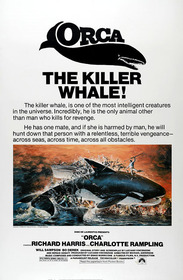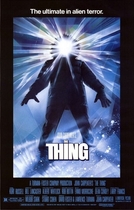Our editor-in-chief Nate Yapp is proud to have contributed to the new book Hidden Horror: A Celebration of 101 Underrated and Overlooked Fright Flicks, edited by Aaron Christensen. Another contributors include Anthony Timpone, B.J. Colangelo, Dave Alexander, Classic-Horror.com's own Robert C. Ring and John W. Bowen. Pick up a copy today from Amazon.com!
Orca: The Killer Whale (1977)
Orca vs. Jaws. Ok, not exactly "The Thrilla in Manila," but Orca could throw a few jabs that would stun Jaws. At least that is the way director Michael Anderson, who also directed the 1976 sci-fi classic Logan's Run, portrays this notorious killer whale. The film features Richard Harris as Captain Nolan, the ancient mariner-whaler; Charlotte Rampling as Rachel Bedford, a seductive, sagacious marine biology professor; and a young, sexy Bo Derek as one of Nolan's compliant assistants. Orca: The Killer Whale, released in 1977, assumes the mantle established by Jaws and takes it one step further. Full of surprises and cinematic bravado, Orca is not the shameless Jaws rip-off some have claimed. In fact, the differences between the two are sophisticated to the point where any close analysis of each can produce equally provocative interpretations.
In Newfoundland, Captain Nolan, a successful whaler, seeks to capture a killer whale but accidentally kills a pregnant female. Its spouse, an eyewitness to this brutal attack, stalks Nolan to seek vengeance for the assassination of its family. Beford, a professor at the local university, is naturally alarmed by this event and educates Nolan about the dynamic character of killer whales. As they flirt with the possibility of a relationship, she pleads with him to leave the beast alone. While Nolan stands on the verge of acquiescing to her demands, the whale makes one final strike to show Nolan he means business. When Orca assaults Nolan's local neighborhood, the whaler reluctantly abandons Bedford's pleas, organizes a team of whale hunters, and embarks on an epic quest to finally destroy the beast. The conclusion reveals an epic battle between man and beast that few films have ever captured.
The beauty of this film is its scientific appreciation of killer whales. In Jaws, the great white is a great mystery (in fact, the behavior of the rogue great white that inspired Peter Benchley to write the novel has yet to be explained by scientists. For more information on that mystery, read Michael Capuzzo's "Close to Shore"). But in Orca, the characters, primarily the professorial Bedford, celebrate the biological and ethological complexities of killer whales in great depth throughout the film. Although the word Orca, which means "bringer of death," resonates with doom, Beford is quick to point out they are the fastest species of whale, grow up to 48 feet, have brains the size of humans, are monogamous, have an instinct for vengeance, and communicate using sonar echolocation. Beford also eagerly notes her research has revealed that killer whales have 15 million pieces of information recorded in their communication patterns; the Bible has four million. Additionally, Will Sampson, most popular for his role as Chief Bromden in One Flew Over the Cuckoo's Nest, plays a local native named Umilak who shares local legends warning Nolan of the power killer whales possess. Finally, unlike in Jaws, where the music, albeit brilliant, was designed primarily to add suspense and drama to the shark's presence, the musical score in Orca adds another dimension to the whale's character. Here, the eerie, avant-garde orchestral music adds great mystery to these animals, especially when the camera shoots them alone at sea in their natural settings.
Two scenes in this film are, quite frankly, two of the most daring I have ever witnessed. The first is the opening scene, which completely dispels the myth of both great whites and the overshadowing presence of Jaws. A scuba diver conducting underwater research alongside Nolan is mistakenly stranded in the water. A great white sizes him up for lunch. At this point, the suspense and memories of Jaws are immediately conjured. However, the audience is thrown a nasty curveball because the great white is the one attacked and tossed out of the water like a beanbag. This scene has scientific merit because it shows the predatory power of killer whales. But the scene also has industry guts because it literally and confidently confronts Steven Spielberg's film industry monster. The other mesmerizing scene occurs shortly after.
As Nolan wrestles with the harpooned killer whale, he finally hauls it aboard ship with the help of a huge pulley. As the monstrous figure of the killer whale looms adjacent to the ship, Nolan and his shipmates suddenly realize the killer whale is pregnant. Within seconds, it self-aborts the fetus to ensure it never lives a minute in captivity and is then quickly tossed back into the ocean. This scene sounds bizarre, but somehow it works. The fetus appears legitimate, and the mates' reactions to this event are powerful. The scene also helps clarify the plot, particularly as the male Orca watches this horror unfold. The courage to even consider these two innovative scenes is worth applause.
This latter scene plays nicely into two of the film's major themes: poetic justice and family values. Later in the film, we learn that Nolan also lost his family in a tragic accident; a drunk driver killed his pregnant wife on the way to the hospital. Nolan sees a part of himself in Orca, or at least a part of himself that should have existed had he sought vengeance against his wife's assailant. This theme plays out well with a close-up of the whale's eye reflecting the silhouette of Nolan. And it is no coincidence that Nolan finally decides to hunt down the whale after it destroys his house. Once again, his home has been destroyed, but this time he plans to do something about it. During the hunt, the sadistic and fatalistic Nolan even proclaims, "He loved his family more than I loved mine," which is probably why he allows the whale to lure him into his own territory: the frigid waters of the far North Atlantic, which are full of glaciers.
What clearly distinguishes Orca from Jaws is the former's use of a female protagonist. In Jaws, hunting and studying sharks is clearly a man's game. But in Orca, the one character who conveys both passion and intelligence about killer whales is a woman. The entire tale is told from her point of view, and her voice serves as the occasional voice-over. This important narrative point reminds us that perhaps the best solution to the age-old conflict between humanity and animals is to understand the beasts with wisdom and knowledge. Bedford defies stereotypes because her compassion for the whale is based on science, yet she affirms them as well because she is the peacemaker among warring males. Nevertheless, she is the last person standing, almost as a spectator, in this ancient bloodlust. At the film's conclusion, she also is seen in almost Biblical, Virgin Mary-like attire, which reminds us that this conflict is epic, primordial, and horrifically tragic.
The cinematography in this film is also powerful, particularly the many panoramic shots of ocean horizons. These shots combined with those of the killer whales at play remind the viewer that Nature itself is a character in this film. In Orca, the theme of animal rights specifically and environmentalism in general is clear and central to the story. In Jaws, it is peripheral. In essence, Orca is a tale that highlights the tragic consequences of shattering the social contract both animals and people share. This point is exemplified when Nolan, after being defeated by the whale, descends in a crucifix-like pose to the ocean's depths, as if to remind us of the sacrifices humanity must make to coexist with the animal kingdom. Perhaps it is no coincidence that the male warrior in Orca dies, while in Jaws, two of the three male warriors survive.
But Orca does have its flaws. At times it is slow and bumpy and in need of more suspenseful scenes. The premise of the plot is, on the surface, silly, if one refuses to buy into any possibility that a killer whale has any degree of complexity. During certain scenes, the screenplay is almost too reminiscent of Jaws. And make no mistake about it: Jaws is one of the greatest films ever made. But Orca isn't so bad either.









Nice review but Orca has a PG
Nice review but Orca has a PG rating not R.
Thanks for the correction;
Thanks for the correction; it's fixed now.
"He went for a little walk! You should have seen his face!"
I think this movie has many
I think this movie has many similiarities with western movies.The end,in particular,remminded me of Clint Eastwood movies: the work is done,so the lonely hero ( in tghis case,the whale) rides alone( swim) towards the sunset( horizent,under the ice).The whale is nameless like some cowboys who make justice with their onw hands inthe movies are.
Don´t know why people insist in this Jaw´s stuff....